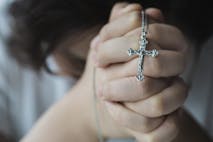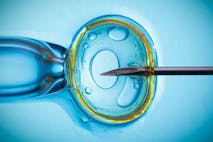
Abortion supporter harasses peaceful pro-life activist in viral video
Cassy Cooke
·
Analyzing AquaWomb: Can artificial wombs ever truly be pro-life?
A new perinatal support device is igniting debate regarding the sanctity of human life, the natural order of human reproduction, and the device's potential ramifications to reach far beyond neonatal care.
Though the purported aim of this technology is to save the lives of the most vulnerable premature infants, it has sparked key concerns from a pro-life standpoint.
A new perinatal support device called the "AquaWomb" is being applauded for its potential to decrease neonatal mortality.
Some argue that it could even have pro-life implications regarding abortion up to "viability," artificial wombs can have serious repercussions and further promote the commodification of children.
Recently, The Guardian featured the AquaWomb, a perinatal life support device meant to provide a lifeline to infants born dangerously early. In essence, AquaWomb was developed to act as a “womb-like life support system” instead of substituting natural pregnancy completely.
Proponents have lauded AquaWomb’s potential to decrease neonatal mortality, with The Guardian article describing how it might do so:
In AquaWomb’s design, the baby is delivered via caesarean section into a fluid-filled pouch, where it can be transferred from mother to machine. Once inside the transfer chamber, clinicians reattach the umbilical cord to a human-made placenta, a fist-sized device lined with catheters delicate enough to pull carbon dioxide from the blood and cannulas robust enough to push oxygen and nutrients in.
If it works, the placenta buys time that the baby’s lungs cannot yet provide. If it fails, the clock runs out in two minutes, the limit before oxygen deprivation risks permanent brain damage. The baby must remain immersed in fluid throughout this entire sequence, never realizing it is being born.One AquaWomb prototype includes access ports that let parents touch their infants. Another features a “uterus phone”, which pipes voices, music or heartbeats into the fluid at the same muffled pitch a fetus would hear in the womb.
Moreover, AquaWomb and similar artificial womb technologies could considerably influence legal definitions of fetal viability, a fact that even pro-abortion voices have not failed to articulate.
In context, many abortion laws globally are premised on the notion of “viability” — the moment which a preborn child is regarded as able to survive outside the womb. This point, historically considered to be about 24 weeks of pregnancy (but entirely subjective), functions as a threshold after which access to abortion is much less accessible.
If a preborn child can survive outside the human body via an artificial womb, “viability” could, some theorize, be defined to be as early as fertilization or shortly after, since almost any embryo could be extricated from the mother’s womb and grown ex utero.
As artificial wombs can push a preborn child's viability threshold earlier in pregnancy, the viability-based limit for abortion would be increasingly untenable, potentially impacting many existing abortion laws and policies.
The introduction of such artificial womb technologies brings about a set of new problems, including how such technologies may normalize the separation of natural pregnancy from childbirth, undermining the special mother-child bond and going down the rabbit hole in terms of other controversial bioethical and social practices. Even The Guardian, a pro-abortion media outlet, admitted:
Article continues below
Dear Reader,
In 2026, Live Action is heading straight where the battle is fiercest: college campuses.
We have a bold initiative to establish 100 Live Action campus chapters within the next year, and your partnership will make it a success!
Your support today will help train and equip young leaders, bring Live Action’s educational content into academic environments, host on-campus events and debates, and empower students to challenge the pro-abortion status quo with truth and compassion.
Invest in pro-life grassroots outreach and cultural formation with your DOUBLED year-end gift!
But the stakes of parental bonding during pregnancy go beyond survival statistics.
Research on families’ experiences with in-vitro fertilization and surrogacy suggests that when pregnancy departs from the normal course, parents – especially mothers – may struggle to feel like proper caregivers. Extremely premature births can invoke similar feelings, in part because prematurity is usually caused by medical complications with the mother rather than the child. "They may not feel they’ve fulfilled their ‘duty’ to protect and carry their child,” says Romanis.
She argues that any ethical alternative to “natural” pregnancy must address parents’ emotional needs alongside infants’ physiological ones. In other words, seeing your baby suspended in a tank or sealed in a bag could alter not only how you connect with them, but how you see yourself as a parent.
Indeed, the very mere existence of this technology could theoretically lead to the prospect of “complete ectogenesis," or the complete gestation of babies ex utero, disconnected from the natural process of conception, gestation, and birth.
From a pro-life view, such a notion is disturbing, as pregnancy has always been more than just a biological process crucial to the nurturing of an preborn child. When a mother is pregnant with her child, she nourishes and nurtures the life developing inside her. A mother is so intimately bonded to her preborn child that her movements, emotions, and voice can influence her baby’s development.
Research on prenatal development have shown that fetuses can identify their mother’s voices and react to her emotional states. Hormones such as oxytocin help create a bond that persists after birth through breastfeeding. Such an intimate relationship cannot be duplicated by even the most advanced of scientific technologies.
It is a pressing (and certainly not unfounded) concern that once normalized, artificial womb technology could pave the way for even greater trivialization and commodification of human life — a dystopian nightmare in which babies could be “grown” at the behest or whims of others, eroding the dignity and meaning of natural conception and pregnancy. Theoretically, this could even eliminate the controversial practice of surrogacy — and the wombs of women altogether — from the process of reproduction.
Rather than experience the comforting rhythms of a mother’s heartbeat and the rhythm of her breathing, a preborn child developing in an artificial womb would miss out on the fundamental bond between mother and child during pregnancy. Even if scientists try to simulate heartbeat sounds or determine environmental variables, such mechanical maneuvers cannot replace what a mother can provide in natural gestation via factors like uterine communication and emotional intimacy. Humans were not meant to be nurtured by machines.
At first glance, AquaWomb appears to be a technologically remarkable feat that may be lifesaving for some premature infants at risk of death. Yet caution must be exercised regarding its widespread use, and society must oppose the temptation to divorce the origins of human life from the primal bonds of motherhood.
Admittedly, the distinction between saving life and redefining it completely is razor thin. The line between assisting life and redefining it altogether is likewise perilously thin; respect for life’s natural beginnings must prevail.
Otherwise, a medical accomplishment like Aquawomb could give rise to the false notion that human life and development are programmable and that a mother’s womb could be conveniently outsourced to machines.
Live Action News is pro-life news and commentary from a pro-life perspective.
Contact editor@liveaction.org for questions, corrections, or if you are seeking permission to reprint any Live Action News content.
Guest Articles: To submit a guest article to Live Action News, email editor@liveaction.org with an attached Word document of 800-1000 words. Please also attach any photos relevant to your submission if applicable. If your submission is accepted for publication, you will be notified within three weeks. Guest articles are not compensated (see our Open License Agreement). Thank you for your interest in Live Action News!

Cassy Cooke
·
Human Rights
Angeline Tan
·
Human Rights
Bridget Sielicki
·
Human Rights
Carole Novielli
·
International
Angeline Tan
·
Human Rights
Nancy Flanders
·
Politics
Angeline Tan
·
International
Angeline Tan
·
International
Angeline Tan
·
Human Rights
Angeline Tan
·
International
Angeline Tan
·